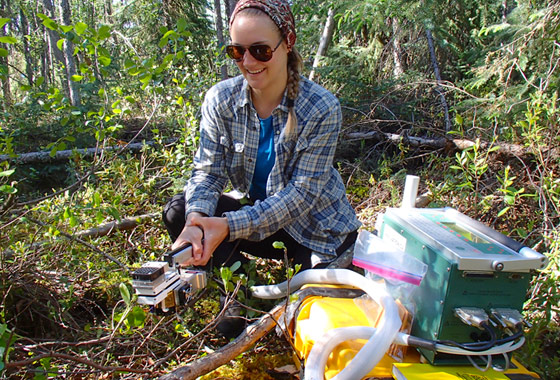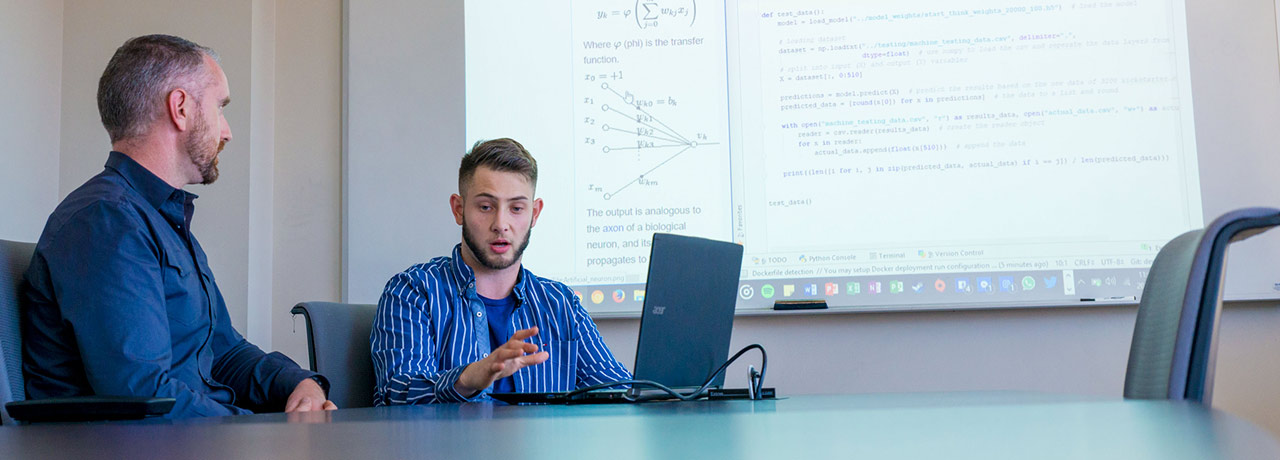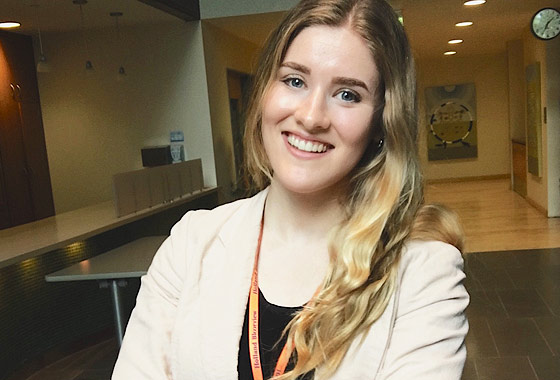Lazy summer? Not for these students. One is in the Northwest Territories taking scientific measurements of plants and soils. Another is in Brantford teaching a computer to predict whether Kickstarter crowdfunding campaigns will succeed or fail. Another is studying children with cerebral palsy at a rehabilitation hospital in Toronto.
They’re just a few of the Wilfrid Laurier University students doing research this summer, whether through co-op terms, full- or part-time research assistantships, or working on their own research through thesis or directed studies courses.
Though Laurier campuses may look quieter than usual, don’t let the short lines for coffee fool you. For many undergraduate and graduate students, summer is their chance to really experience research. That's certainly the case for Jenna Rabley, Andre Fischbacher and Emma Smith. Here are their stories.
Jenna Rabley has a not-so-typical commute to her job site.
“Our study sites are in a plot that we have to paddle to, which normally takes about 20 minutes, followed by a 20-minute hike to get into the plot,” Rabley says, explaining how she gets from the Scotty Creek Research Station camp in the boreal forest south of Fort Simpson, Northwest Territories, to the sites where she is working as a research assistant to PhD student Katherine Standen.
For Rabley, who just finished her undergraduate biology degree in the ecology, biodiversity and evolution stream, this is her second consecutive summer in the Northwest Territories. Last summer, she was a research assistant working with master’s candidate Katie Black in Trail Valley Creek, farther north in the tundra near Inuvik. Her honours thesis research also involved fieldwork at Trail Valley Creek.

This summer, she’s helping Standen collect data primarily in the Scotty Creek area, but also in northeastern British Columbia and central Saskatchewan. The goal of the project is to understand the effects of permafrost thaw on plants.
“Climate warming has caused temperatures in the north to increase at a faster rate than the global average,” says Rabley. “This causes nutrient-rich soil that was once frozen to thaw. Katherine has designed several experiments to understand the implications of nutrient availability and how this alters plant function and communities in the boreal forest.”
The research involves taking measurements of the depth and thickness of permafrost and the organic layer of soil on top, as well as measuring the density of the tree canopy and biodiversity on the forest floor.
“The work is being done in a partnership with the Government of the Northwest Territories, so I’m very happy to be contributing to something that helps us understand how the environment is changing in response to global climate change,” says Rabley. “I’m hoping that some of the research I do will go toward inspiring change that will help mitigate the effects of global warming.”
There are, of course, challenges. The fieldwork can be physically demanding because it involves hiking difficult terrain, often while carrying heavy scientific equipment. Rabley works long days, six days a week, starting early in the morning. Her social life is limited, as is her access to the Internet.
Nonetheless, Rabley says she loves that so much of her job consists of spending time in nature. She loves the North, right down to the smell of the forest.
“Scotty Creek is on a lake in the boreal forest. You can often sit on the dock and see loons swimming in the lake or hear various species of birds perched on black spruce trees singing and listen to the wind blowing through the trees,” she says.
Rabley plans on starting a master’s in biology at Queen’s University in January, and aspires to a career collecting and assessing data outdoors, ideally in the North.
She says the research experience she gained at Laurier – through her research assistantships, volunteering in the labs of associate professors Jennifer Baltzer and Kevin Stevens and through doing her honours thesis – has been invaluable.
“I gained insight into what graduate work entails, met and formed relationships with individuals I now consider lifelong friends and was given opportunities I would not have otherwise received, including working in various areas of the Northwest Territories. It is also amazing to have the chance to travel within Canada and do what I love.”

Andre Fischbacher is doing research not for pay, but for credit. He’s doing a directed studies course this summer with Assistant Professor Kevin McDermott, helping him with research on predicting whether Kickstarter crowdfunding campaigns for new business ideas will succeed or fail.
It’s part of the full course load the Brantford campus student is maintaining during the very last semester of his Business Technology Management program – but for him, it’s not just another course.
“I love it, I really do,” says Fischbacher. “I love researching the development of new companies, new ideas coming to life.”
For the last year and a half, McDermott has been collecting electronic data about more than 33,000 past Kickstarter campaigns, including more than 500 points of data per campaign. The data includes factors such as whether the company is from a city or town, from the U.S. or Canada, the type of industry, the number of times the campaign is shared on Facebook and many more.
It adds up to more than 16.5 million data points and Fischbacher is analyzing it all. Or rather, he’s a teaching a computer to analyze it for him.
It’s called machine learning or an artificial neural network – “the same type of algorithm that Amazon uses to predict what types of products you’re likely to want to buy next,” says McDermott.
A computer deciding whether a Kickstarter campaign will succeed or fail is like a human deciding whether to cross a street, says Fischbacher, who has been programming since Grade 10 and is largely self-taught.
When we decide whether to cross a street, we take into account factors such as lights, traffic volume, car speeds, weather and obstructions. With experience, some of these factors start to seem more important than others. This is basically how Fischbacher and McDermott’s algorithm will work, except that it will analyze 500-plus factors.
Fischbacher and McDermott expect that when their work is done, the algorithm will be able to predict whether a Kickstarter campaign will reach its monetary goal with 80 per cent accuracy. In their tests with nearly 2,000 campaigns, they achieved an 81 per cent accuracy rate.
They hope to publish a journal article first, then create a web portal that will allow the public to input the URL of a new Kickstarter campaign and find out within a few seconds whether it’s likely to succeed.
“It has been very gratifying to work with Andre this summer, ” says McDermott. “The quality of his work is great. He has independently selected appropriate technologies and made important research decisions on his own. His enthusiasm and willingness to learn have made a valuable contribution to moving our research forward.”
In September, Fischbacher will start a job doing software engineering for the Bank of Montreal, a position he landed through the Laurier Career Centre. Though it’s a step away from research, at least for now, he’s glad he’s had a chance to do hands-on research with McDermott this term.
“I enjoy it so much and Dr. McDermott is such an awesome guy. He really wants me to succeed,” says Fischbacher, adding that he feels he has made a real contribution. “It’s a small step for computer science, but a huge step for me.”
Emma Smith, a third-year psychology student, is working a co-op term at Holland Bloorview Kids Rehabilitation Hospital in Toronto. Her job consists of assisting with four studies at the hospital’s Cerebral Palsy Discovery Lab.
“I’ve been really interested in research for a couple of years now and I’ve been very eager to get experience working in a hospital and learning about health care in general,” said Smith. “For my co-op term last year I worked with kids with disabilities, so when this came along I was really excited to be in the same area but on the research side.”
For Smith, one of the best things about her summer job is the chance to get involved with research projects at different stages.

Two of the projects she’s working on are just setting up. Both of these will conduct research with children at therapeutic camps this summer. One focuses on using exercise video games specially set up so children of differing abilities can play together. The other is at a sports camp and involves stimulating the brain with mild electrodes while constraining the dominant side of the body, if the children have one. The idea is to encourage children with cerebral palsy to develop their non-dominant sides.
“I really like learning about the process of starting a study,” says Smith. “I found it interesting seeing how you get ethics approval and appreciating how much work goes into that, how much care there is surrounding ethics and making sure everything is conducted properly.”
Smith will also help with the camps once they start and expects working directly with the children to be a highlight.
On the other end of the research process, Smith is helping analyze data from two studies that have already completed their experimental phases. One is assessing the effectiveness of Botox injections for muscle stiffness in children with cerebral palsy. The other followed children over three years as they worked on personal physical goals ranging from walking five steps unassisted to learning how to ride a bicycle.
“Seeing the progress of the studies has been a good learning experience,” she says. “I’m learning a lot about things that I touched on briefly in classes but now I’m getting hands-on experience. Specifically, I’m getting feedback on my writing skills, which will be really valuable for fourth year. We’ll also be preparing poster presentations at the end of the summer so it will be excellent to learn what that’s like before I have to do it for my honours thesis.”
Smith hopes her work will result in being listed as a co-author on at least one journal article. Even if that doesn’t happen, though, she says her co-op research experience has been more than worthwhile.
“It feels like a great start for a career path.”